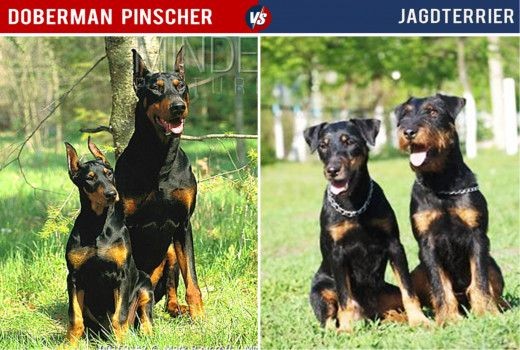
The Doberman Pinscher, with its distinctive appearance and noble bearing, has several canine lookalikes that often cause confusion among dog enthusiasts. While some breeds share the Doberman's black and tan coloring, muscular build, or facial features, each has its unique traits and heritage. From the ancient Beauceron to the modern German Pinscher, these breeds showcase varying degrees of similarity in physical characteristics and temperament. Understanding these similarities and differences is crucial for potential dog owners, breed enthusiasts, and professionals in canine fields who seek to make informed decisions about these remarkable breeds.
Physical and Behavioral Similarities to Doberman
Size and Build Comparisons
Several breeds share physical characteristics with Dobermans. The Beauceron matches Dobermans closely in height for both males and females, with a similarly athletic and muscular build. The German Pinscher, while slightly stockier, exhibits comparable elegance with a slim yet powerful physique. The Chippiparai from India also displays an elegant build reminiscent of Dobermans, though with a more slender frame typical of sighthounds.
Alternative Options for Restricted Housing
For those unable to own Dobermans due to housing restrictions, several breeds offer similar traits in more widely accepted packages. The Standard Poodle presents an excellent alternative, being slightly smaller while maintaining comparable intelligence, athleticism, and trainability. Though requiring more frequent professional grooming, they don't face the same breed restrictions. The Flat-Coated Retriever offers another option, matching Dobermans in smarts and activity levels, though lacking the guarding instinct. For those needing smaller alternatives, the Miniature Poodle maintains similar personality traits in a more compact size suitable for apartment living.
Understanding the Beauceron vs Doberman Physical Differences
Coat and Color Distinctions
While both breeds share black and tan markings in similar patterns, the Beauceron has a thicker double coat compared to the Doberman's shorter, sleeker single coat. The Beauceron can also come in a distinctive harlequin (merle) pattern, which is not found in Dobermans. The Beauceron's coat requires more maintenance due to heavy shedding, whereas Dobermans need minimal grooming beyond occasional brushing.
Structural Differences
A key distinguishing feature of the Beauceron is the presence of double dewclaws on their rear feet, which must be firmly attached according to breed standards. The Beauceron is generally stockier in build compared to the more streamlined Doberman. Unlike Dobermans, Beaucerons are never docked and maintain their natural tail and ear shape. The Beauceron's facial structure is also notably different, with a broader head and less pronounced stop compared to the Doberman's more refined and chiseled features.
Comparing Personality Traits and Working Roles Between Beaucerons and Dobermans
Maturity and Training Differences
While both breeds are highly intelligent, the Beauceron develops more slowly, taking longer to mature both physically and mentally. They tend to bore easily with repetitive training and are less forgiving of handler errors compared to Dobermans. Dobermans, while sometimes stubborn, are generally more biddable and adapt better to consistent training approaches. The Beauceron's herding background makes them more independent thinkers, whereas Dobermans were specifically bred to work closely with humans as personal protectors.
Purpose-Driven Behaviors
The breeds' distinct historical purposes shape their working styles differently. The Beauceron originated as an all-purpose farm dog in the 1500s, combining herding and guarding abilities. This dual-purpose background results in stronger herding instincts and a more territorial approach to protection. In contrast, Dobermans, developed specifically as human guardians in the 1890s, display more focused personal protection traits and stronger handler bonds. While both breeds excel in military and police work, Beaucerons maintain stronger instincts for controlling and gathering animals, while Dobermans prioritize human-oriented tasks and personal protection.
Distinctive Traits of Lesser-Known Doberman Look-alikes
Unique Characteristics of Rare Breeds
While previous sections covered well-known breeds similar to Dobermans, several rare breeds also share resemblances. The Indian Kanni Dog exhibits a slim, muscular build like Dobermans but with distinctive white markings on the muzzle, eyebrows, and chest. Though gentle with families, they maintain strong guarding instincts. The Chippiparai, another Indian breed, combines Saluki and local bloodlines to create an elegant appearance similar to Dobermans but with a more pronounced hunting drive.
Specialized Working Capabilities
Unlike the protection-focused traits discussed in previous sections, some Doberman-like breeds excel in specialized roles. The German Hunting Terrier shares the black and tan coloring but is half the size of a Doberman and specifically bred for pursuing prey into burrows. The Pharaoh Hound, while similar in build and facial structure to Dobermans, possesses unique traits like naturally erect ears and exceptional agility suited for hunting rather than protection work. These breeds demonstrate how similar physical characteristics can serve different working purposes, from specialized hunting to varied terrain navigation, distinguishing them from the Doberman's focused role as a personal guardian.
Conclusion
The research identified several breeds that share physical and behavioral similarities with Dobermans, each offering unique characteristics that may appeal to different owners. The Beauceron stands out as one of the closest matches in terms of size and build, though it differs in coat type, maturity rate, and working style due to its herding heritage. For those facing breed restrictions, the Standard Poodle and Flat-Coated Retriever present viable alternatives, matching the Doberman's intelligence and activity levels while being more widely accepted in restricted housing situations.
The findings highlight important distinctions between superficially similar breeds, particularly in terms of working roles and personality traits. While breeds like the Beauceron, Indian Kanni Dog, and Chippiparai may resemble Dobermans physically, their different breeding histories have resulted in distinct behavioral characteristics and specialized capabilities. This understanding is crucial for potential owners to make informed decisions based not just on appearance, but on how well a breed's inherent traits align with their lifestyle and needs.